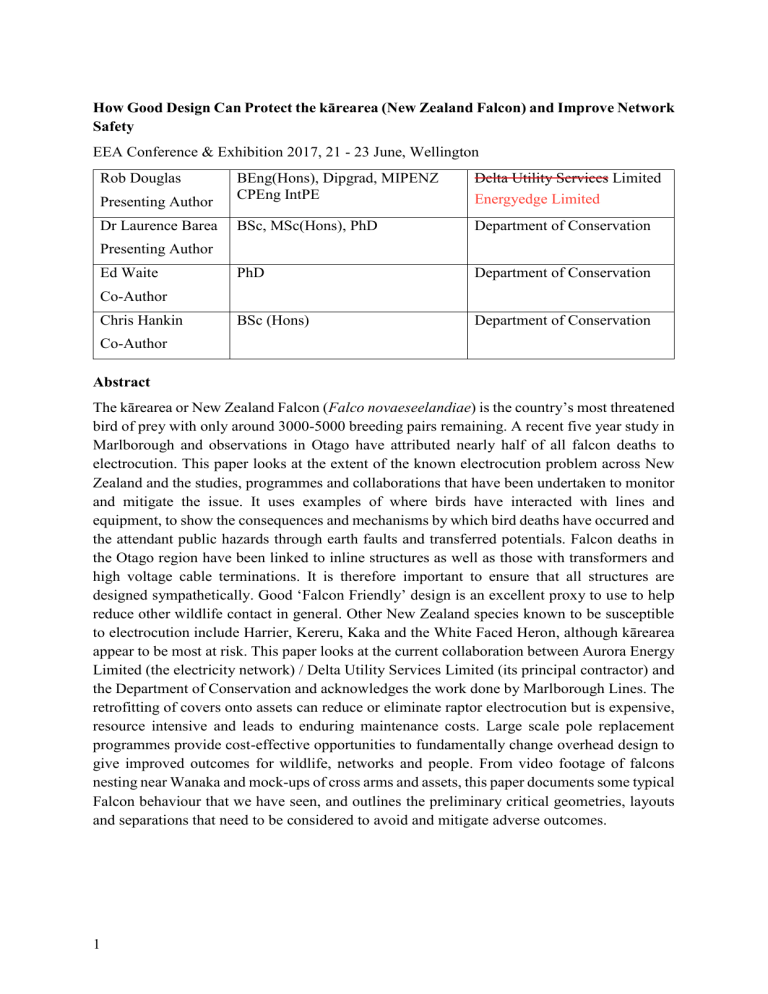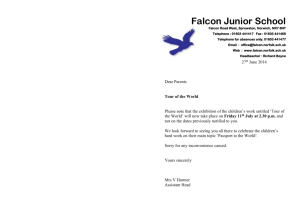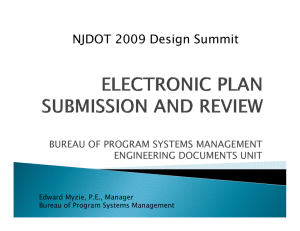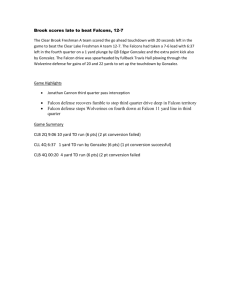
How Good Design Can Protect the kārearea (New Zealand Falcon) and Improve Network Safety EEA Conference & Exhibition 2017, 21 - 23 June, Wellington Rob Douglas Presenting Author BEng(Hons), Dipgrad, MIPENZ CPEng IntPE Delta Utility Services Limited Energyedge Limited Dr Laurence Barea BSc, MSc(Hons), PhD Department of Conservation PhD Department of Conservation BSc (Hons) Department of Conservation Presenting Author Ed Waite Co-Author Chris Hankin Co-Author Abstract The kārearea or New Zealand Falcon (Falco novaeseelandiae) is the country’s most threatened bird of prey with only around 3000-5000 breeding pairs remaining. A recent five year study in Marlborough and observations in Otago have attributed nearly half of all falcon deaths to electrocution. This paper looks at the extent of the known electrocution problem across New Zealand and the studies, programmes and collaborations that have been undertaken to monitor and mitigate the issue. It uses examples of where birds have interacted with lines and equipment, to show the consequences and mechanisms by which bird deaths have occurred and the attendant public hazards through earth faults and transferred potentials. Falcon deaths in the Otago region have been linked to inline structures as well as those with transformers and high voltage cable terminations. It is therefore important to ensure that all structures are designed sympathetically. Good ‘Falcon Friendly’ design is an excellent proxy to use to help reduce other wildlife contact in general. Other New Zealand species known to be susceptible to electrocution include Harrier, Kereru, Kaka and the White Faced Heron, although kārearea appear to be most at risk. This paper looks at the current collaboration between Aurora Energy Limited (the electricity network) / Delta Utility Services Limited (its principal contractor) and the Department of Conservation and acknowledges the work done by Marlborough Lines. The retrofitting of covers onto assets can reduce or eliminate raptor electrocution but is expensive, resource intensive and leads to enduring maintenance costs. Large scale pole replacement programmes provide cost-effective opportunities to fundamentally change overhead design to give improved outcomes for wildlife, networks and people. From video footage of falcons nesting near Wanaka and mock-ups of cross arms and assets, this paper documents some typical Falcon behaviour that we have seen, and outlines the preliminary critical geometries, layouts and separations that need to be considered to avoid and mitigate adverse outcomes. 1 Introduction This paper is written for both an engineering and ornithological audience and endeavours to include both the utility and conservation perspectives and nomenclature. It is intended to raise awareness of the Falcon electrocution issue in New Zealand and to encourage and inform the sympathetic designing of high voltage assets. It is anticipated that such considerations will be increasingly requested in the resource consenting processes. Although this paper considers only kārearea and voltages at and below 11kV it can be used as a reference for other species and voltages. It is considered that improved designs that satisfy falcons will also provide wider benefits to other species including humans through improved safety and reliability. In this paper the Māori name kārearea will be used exchangeable with Falcon; both refer to the New Zealand Falcon (Falco novaeseelandiae); New Zealand’s only falcon species. It should be noted that there are three ecological forms of the kārearea in New Zealand; the measurement data is taken from the ‘Eastern’ form. There are also many other species of falcon across the world, which includes kestrels, with a large size variation across species; physical measurements given in this paper are not to be applicable to other species. Background The kārearea or New Zealand Falcon (Falco novaeseelandiae) is the country’s most threatened bird of prey with only around 3000-5000 breeding pairs remaining. Both a five year radio tracking study [1][2] of released birds in Marlborough and an observational study [4] in Glenorchy have attributed nearly half of the bird deaths to electrocution on 11,000 volt distribution transformers and structures. Although the two studies gave similar results it should be noted that Marlborough study pertained to released birds in a viticulture environment with limited high perch availability whilst the Glenorchy study consisted of a wild population close to a native bush environment. The kārearea is the only indigenous member of the falcon genus in New Zealand. The species is geographically variable, with three forms being recognised, based on their habitat association and geographic distribution within New Zealand. Large ‘eastern’ falcons inhabit open habitats in the South Island high country, mainly east of the Southern Alps. The ‘southern’ falcon is found in the forests of Fiordland, Stewart Island and the Auckland Islands. Smaller and darker ‘bush’ falcons are associated with forested habitats on the west coast of the South Island from Nelson to approximately south of Greymouth. The bush falcon also inhabits forests and associated habitats in the North Island. Mechanisms of Electric Shock The interaction of birds with electricity lines is very difficult to avoid given the shared environment. Adverse outcomes occur when the separations of conductive parts are similar to or smaller than the size of the birds that interact with them and as the number of interactions 2 increase. Increasing electrical separations or insulating live or conductive parts removes or mitigates electrocution risk. A bird suffers an electric shock when it bridges two points at significantly different voltages. The degree or severity of the electric shock depends on the body current which in turn depends on the resistance of the circuit that it completes. The lower the resistance of the circuit the higher the body current and risks of injury or fatality. Wooden crossarms, wooden poles and flight feathers provide high resistance paths, while metal crossarms, metal & concrete poles and tissue afford a lower one. Figure 1: Legacy Inline Concrete Pole 1968 - Structure 37516 – 821 Insulators and 1.8m Wooden Crossarm In order to determine likely mechanisms and risks of an electric shock on a specific structure we must first determine or assess: [1] [2] [3] [4] [5] The geometry of falcons. Injurious body currents. The critical bird contact points and the associated resistance. The geometry of the structure. Likely bird behaviour on the structure. Determination of Falcon Geometries The critical contact points are considered to be the feet, chest, manus “hand” and carpal tissue areas. High voltage testing (see below) indicates that primary feathers are highly resistive and even when wet are unlikely to facilitate fatal body currents or injuries. Distance: Female Male 3 Figure 2 Foot to Head (Perching) A Foot to Tail Tail B C Outer “Hand to Hand” (Manus Tissue) D Wing Length Wing Span E F Mean [µ] 276 153 199 375 289 834 SD [σ] 10 18 6 82 7 70 n 8 8 7 7 9 7 Mean [µ] 233 136 176 315 255 721 SD [σ] 16 16 2 14 4 42 n 2 2 2 2 2 2 Table 1: Falcon Morphometric Data – Electrocuted Specimens (all measurements are in mm) Table 1 contains the measurements of the dead falcons handed into the Department of Conservation’s Glenorchy field office between 2005 and 2015. As can be seen, female falcons are significantly larger than males (sexual dimorphism) and based on this alone may be at elevated risk of being electrocuted [1]. They are therefore used as the basis for defining critical geometries. The 95th percentile on the normally distributed population is considered to be a reasonable assumption for maximum size1. These critical distances are summarised in Table 2. As a starting point for discussion the chest height is assumed to be 2/3rds of the perching height. µ+2σ (> 95th Percentile) Foot to Head (Perching) (Figure 2 = A, n=8) 296 mm Outer “Hand to Hand” (Manus Tissue) (Figure 2 = D, n=7) 539 mm Centre Body to Outer “Hand” (Manus Tissue) (D/2) 269 mm Foot to Chest (Perching) (2/3*A) 197 mm Table 2: 95th Percentile Geometrics based on Female Specimens) Figure 2: Bird Measurement Distances (See Definitions) Assessing Injurious Body Currents Trying to predict and define a safe threshold of body current for a ‘typical’ falcon is difficult given the lack of data and the number of variables. In order to suggest a magnitude for such a current we have used information from the poultry industry, assuming that the data are relevant to raptors, and undertaken testing of our own. Veterinary sources indicate that electrically shocking an animal is an unreliable method of euthanasia. This is also suggested in information from the poultry industry [7][8] that documents the highly variable nature of the resistance and current path even when under the highly controlled conditions (see Table 3) and further evidenced by Fox and Wynn [1][2] where they document examples of where birds have been shocked and then fully recover. Guidelines from the poultry industry indicates that minimum currents of 100mA (50Hz) be achieved for the stunning of chickens using a water bath prior to slaughter (European Regulations). In this method the birds are suspended by their feet along a chain with their heads (eyes) submersed in the water bath; so creating a low resistance path. The current is typically applied for several seconds. 1 This sample set has been tested against published data for tail length: no sample bias was found. 4 Bird type Average resistance [Ω] (SD) Live weight [kg] Average (range) Egg-laying chicken 2500 – 2900 (500 - 800) 1.9 (1.3 - 2.4) Guinea fowl 2900 (1400) 1.2 – 2.3 Table 3: Typical resistance of poultry used for water bath stunning method [8] Resistance Testing To gauge the likely body resistance of a falcon, a fresh ‘road-killed’ Australasian harrier (Circus approximans) was tested in the high voltage laboratory at Delta. Foot to wing-tip (primary feathers), wing-tip to wing-tip and carpal tissue to foot leakage currents were all tested at voltages up to 6350V (the nominal line to ground voltage of an 11kV distribution system). These results are summarised in Table 4 below. As can be seen the resistance from the carpal tissue area is four orders of magnitude lower than the resistance involving the primary feathers; roughly 60,000 Ω. A second stage of testing was undertaken in which the primary flight feathers were removed and soaked in water for up to 30 minutes. This was also followed up with the soak testing of some kārearea flight feathers borrowed from the Marlborough Falcon Conservation Trust (MFCT) Figure 3. These results are summarised in Table 5. Figure 3: HV testing of kāhu or Australasian hawk (Circus approximans) and kārearea feathers (right). From Voltage [Volts] Body Current [µA] Condition Resistance [MΩ] V I R=V/I Wingtip Wingtip 6350 7.9 Dry 804 Wingtip Foot 6350 180.0 Wet - Sprayed 35 Wingtip Foot 6350 190.0 Wet - Sprayed 33 2 Carpal Tissue Foot 400 7000.0 Wet - Sprayed 0.057 Wingtip Foot 6350 11.0 Dry 577 Wingtip Foot 6350 12.0 Dry 527 Table 4: Summarised result of HV testing of testing of kāhu or harrier hawk (Circus approximans) 2 To Not tested beyond low voltage to avoid equipment damage 5 Species Harrier Harrier Harrier Harrier Harrier Harrier Falcon Falcon Falcon Falcon Falcon Falcon Sample Soak time [minutes] Feather Length [mm] kV Leakage Additional Current Test Length [µA] [seconds] 1 Dry 280 6.6 10 5 30 270 6.6 350 5 30 270 6.6 320 30 5 30 270 6.6 280 45 5 30 270 6.6 250 60 5 30 270 6.6 190 75 1 Dry 230 6.6 7.6 6 30 220 6.6 80.2 6 30 220 6.6 9.4 30 6 30 220 6.6 9.2 45 6 30 220 6.6 9.3 60 6 30 220 6.6 9.3 75 Table 5: Sample of results of HV testing of testing of Hawk and falcon flight feathers The results obtained above suggest that contact between a bird’s flight feathers, away from any tissue, and a high voltage exposed live part would not likely lead to an injurious or fatal electric shock as the body current would be less than 1 mA. 1mA is two orders of magnitude less than that used to stun poultry. Tissue contact, however, between an exposed live part and earth or another phase should be considered potentially injurious or fatal. Dimensions therefore that include primary flight feathers are not as critical as those that involve tissue. The Geometries of Structures In the Marlborough study, [1][2] distribution transformer structures were involved in the majority of the tracked falcon deaths. In the Glenorchy study [4] transformer structures have also been involved as have cable terminations, a recloser and an inline structure. The implication that an inline structure (see Figure 1) could cause an electrocution was a concern given their ubiquity. The following items on structures are considered critical: [1] Distribution Transformers. [2] High Voltage Droppers. [3] Crossarms, conductive poles and insulators. We will look at each of them in turn and show critical points and mitigation measures. Distribution Transformers and High Voltage Bushings 11,000 volt transformers typically have the live connection of the bushings separated by a horizontal distance of over 200mm. Older bushings are typically shorter than newer ones in the range 170 to 210mm in height for 11kV bushings. A bird in contact with the side of the bushing, whilst its feet are on the earthed metal tank, is highly unlikely to receive an injurious electric shock as the bushing’s surface resistance is 6 designed to be very high even when wet with any shock current likely to in the micro-amps (µA) range. At 11kV a falcon would have to get within 3 mm from the exposed live part of the bushing for a ‘flashover’ to occur3. The side of the bushing is well beyond this distance. Contact with (or very close to) the metal cap, lug or exposed high voltage droppers would very likely lead to a shock. Again the outcome would depend on whether tissue contact was made, how ‘imperfect’ the contact was and physiological factors. Point of Contact 1 Point of Contact 2 Injurious Electric Shock Risk Side of Bushing Transformer Lid (metal) Low Top of Bushing (porcelain) Transformer Lid (metal) Intermediate Top of Bushing 1 (metal) Transformer Lid (metal) High Top of Bushing (porcelain) Top of Bushing (porcelain) Intermediate Top of Bushing 1 (metal) Top of Bushing 1 (metal) High The taping or covering of bushings is considered a very effective way to reduce transformer risks. The use of bird guards (left Figure 4) is considered good as is the use of medium voltage fusion tape (MVFT). The hard retrofitted covers were found to be difficult to apply in Glenorchy with cables ties used to supplement their securement on surge arresters; cable ties are likely to have a limited life in such an environment. It is unclear at this stage how long fusion tape (MVFT) will remain adhered to the bushing before reapplication is required. Figure 4: Examples of bushing coverings – Standard Practice (Dunedin), Tyco BCAC covers (Takaka), Medium Voltage Fusion Tape + PVC Tape GO11 (Glenorchy) High Voltage Droppers High voltage dropper leads feed power down from the overhead lines to fuses, transformers, cables, overhead lines or other assets. The vertical distances vary but can be several metres in total with the occasional intermediate support and fuse arms. High Voltage droppers can be PVC covered or bare depending on age and practices of the network. Dropper lead separations 3 The dielectric strength of dry air is taken as 3kV/mm. 7 (phase-phase) typically reduce as they descend towards transformer bushings or cable terminations. The consideration and design of droppers, including the items they supply (e.g. fuses and surge arresters), is therefore seen as vital in the process to asses and mitigate risks, especially where they are near platforms where falcon are likely to perch (e.g. transformer tank lids and crossarms). Split tubing is typically used to cover bare dropper leads. We have found however, through recent testing, that PVC covered low voltage conductor (manufactured to AS/NZS 5000) had a consistent electrical strength of over 30kV. This testing used 6 sections of new conductor with 1 metre of their length immersed in a water bath. Our judgement backed up by many years of use is that such black PVC covered conductor is likely to retain adequate integrity for several decades against intermittent bird contact and UV damage at and below 11kV. It is recommended that as a minimum, and until this or alternatives have been verified, all HV droppers use black PVC covered conductor with split-tubing used to supplement it where possible. Split tubing should always be used at higher voltages above 11kV as PVC covered conductor is unlikely to afford any safety factor. Figure 5: How repositioning or covering the HV droppers (black) can improve outcomes (porcelain bushings brown) Inline Structures, Crossarms and Insulators As can be seen from Figure 1, the size of the falcon next to the legacy 821 insulators demonstrates the risks on structures such as these. The top of the insulator is at 6350 volts to the head of the conductive concrete pole. In the case shown by figure 7 it is believed that the falcon was electrocuted by bridging the pole (its chest is at insulator neck height) and the binding wire around the top of the insulator to complete a circuit. 8 ≈11,000 volts line to line (or phase to phase) ≈ 6,350 volts line to earth Figure 6: Electrocuted Falcon - Pole 37516 - 821 – Glenorchy – Chest, Leg and Talon Wounds The height and offset of the 821 insulators from the head of the pole and small 1.8m crossarm are unfortunate. Based on physical measurements, it is unlikely for a falcon to bridge the 500 mm or so between two insulators/lines (phase to phase) with tissue-tissue (manus) contact. The legacy type of crossarm shown in Figure 6 is now being replaced with the design below affording improved clearances (Figure 7) and reduced electrocution risk. Figure 7: Modern 2.4m crossarm design with larger line post insulators Falcon Behaviour on Structures From photos and observations, it appears that falcons may have a preference for perching on crossarms and the heads of poles as opposed to the less-natural surface of insulators. However, this requires verification. They prefer perches with good height and visibility when looking for prey and a good flat platform for eating it. It has not been observed that falcons regularly land on cable terminations, reclosers or fuses but may be merely victims of the extra live parts, crossarms and reduced clearances that exist on such structures. 9 Further reports, observations and the introduction of mock up structures in Marlborough will lead to more understanding. Falcon ‘Streamers’ (Excrement Streams, Liquid Faecal Streams) Alongside eating, falcons have a related natural behaviour, that of excreting. As is clearly visible in Figure 8, faecal ‘streamers’ are of significant length and regularly between 300500mm. Should a conductive streamer be emitted by a falcon and bridge conductive parts then a fault current will flow and which could lead to a significant electric shock. The risks of such an event are heightened on conductive concrete or metal poles and crossarms and where fuses and droppers are located close to perches. Designers should consider the eventuality of such events and try to improve designs accordingly. The apparent preference for falcons to perch on lower conductivity crossarms (see above) as opposed to insulators, if real, reduces some of the likelihood of a streamer event between lines and an earthed structure. As a guideline for discussion we proposed a maximum ‘streamer’ length of 500m at an angle of 40º to vertical be considered. Copyright Fairfax Media NZ See Link Figure 8: Example of Falcon ‘Streamer’ – “Hawkie” – Fairfax Media NZ – June 2016 [9] – MFCT Aviary Wall Initiates and Collaborations: Marlborough Lines Marlborough Lines started insulating the bushings of transformers in 2009 when it was identified, in a radio tracking study [1][2], that close to half of all falcons released between 2005-2010 had been electrocuted on high voltage structures, predominantly (7/10) transfomer structures. They now have a policy in place to tape the exposed bushings of new transfomers in relavant areas with medium voltage fusion tape (MVFT) and to install split tubing onto the drop leads (“droppers”) upto a distance of 600mm from the bushing. So far it is estimated that around a hundred transformers have been protected in this way. 10 The released falcons were introduced as part of the Falcons for Grapes scheme in conjunction with the Marlborough Falcon Conservation Trust. Delta Utility Services Limited and the Department of Conservation In 2015 Delta Utility Services Limited formed a conservation partnership (MOU) with the Department of Conservation to address the issue of falcon deaths. This partnership has become KāreareaSafe and has so far seen: The retrofitting of four structures in Glenorchy4. The incorporation of enhanced falcon friendly requirements into Network policy The preparation of educational material including information panels in Glenorchy and brochure5. The ongoing development of the KāreareaSafe certification/labelling scheme for structures. The new wildlife protection sections in both Overhead and Substation design and construction standards [10][11] reads as follows: “KāreareaSafe / FalconSafe: Delta and the Department of Conservation are working together to reduce the risk of kārearea / New Zealand falcon being electrocuted when interacting with overhead power lines and equipment. To this end all new HV structures should be designed and constructed to minimise these risks where practical; existing structures should be modified or retrofitted during maintenance works again where practical. All droppers to HV equipment (e.g. fuses, transformers, links and reclosers) shall be either PVC covered (AS/NZS 5000) or fitted with approved split tubing with all bushings and cable terminations fusion taped to cover exposed live parts.” Figure 9: KāreareaSafe label planned to be installed on certified poles 4 These were for test purposes only, to support the development of the final recommendations you are putting in this paper. 5 The information panels at Glenorchy are to be installed in the near future. 11 Provisional Recommendations All distribution transformer bushings connections should be taped or covered. Taller bushings and insulators should be considered on transformers and overhead structures. All HV droppers should use black PVC covered conductor with split-tubing used to supplement it where possible. Split tubing or an alternative should always be used at voltages above 11kV. The industry should move to the use of “hand to hand” (Manus Tissue) distances as opposed to “wrist to wrist” (Carpal Tissue) as this better reflects the maximum anticipated tissue to tissue span of birds. Network drawings and designs should incorporate wildlife symbology and graphic representations so to acknowledge the shared operating environment and raise awareness. Animal contact and interactions (for example faeces or remains) should be recorded as part of inspections to identify high interaction sites. The number structures that have been assessed to be sympathetic to kārearea should be documented in a networks Assets Management Plan (AMP). Members of the public should be further encouraged to photograph and report falcons or other significant birds on electricity structures. Next Steps This paper, it is hoped, will raise awareness of the kārearea electrocution issue in New Zealand and encourage the increasingly sympathetic designing of high voltage assets and fuel further reporting. It is also intended that the provisional findings of this paper will allow the prioritisation of structures that are not sympathetic. Further work using mock-up cross arms, sensors and cameras is planned by DoC at the MFCT aviaries in Marlborough to study the behaviour of falcons on such structures. From this work it is hope that risks can be quantified so that further funding can be sought for targeted initiatives. Conclusion Given that electrical structures typically have a design life of 50 years it is critically important that good design principles are followed at the outset. Sympathetically designed structures need not cost any more. It is in no one’s interest to harm threatened wildlife; we must as an industry acknowledge the issue and work towards an industry wide solution. 12 Definitions Low Voltage is defined as an AC voltage at or below 1000V or a DC voltage at or below 1500V High Voltage is defined as an AC voltage above 1000V or DC voltage above 1500V. Streamers are long excrement streams from large birds. If a continuous path of conductive liquid faeces bridges conductive parts at different voltages (e.g. bird on wire to earthed conductive structure: concrete/steel) a circuit is formed which can lead to a fault and electric shock to the bird. Primary Feathers are flight feathers attached to the outside of the wing, manus or “Hand”. Carpus or carpal bones or “wrist” is the sole cluster of bones between the radius and ulna and the metacarpus. Manus Tissue is tissue located around the Manus or “Hand” of the bird consisting of the Metacarpus and Phalanges. Wing Length is taken as Carpus or “Wrist” to longest [un-straightened] primary, measured straightened. Wing Span is taken as distance between longest primary feathers with wings stretched. Tail Length measured tail tip to where feathers leave body Foot to Tail distance, measured leg natural perched position measured foot pad to tip of tail Foot to Head distance, measured leg natural perched position measured foot pad to top of head Electric Shock is the physiological reaction, sensation, or injury caused by electric current passing through the body. Electrocution a fatal electric shock Transformer Bushings are insulators used to bring a high voltage supply into a transformer without contacting the earthed metal tank. Typically porcelain with conductive centre. Cable Terminations are used to transition from an overhead reticulation network to an underground cable one. High voltage terminations typically involve “dropper leads” to metal cable bracket “a crucifix”. Surge Arresters are used to help protect power system equipment and consumers from lightning strikes and other voltage surges on the Network. 13 References [1] Fox, N.C.; Wynn, C. 2010. The impact of electrocution on the New Zealand falcon (Falco novaeseelandiae). Notornis 57(2): 71-74.] [2] Fox, N.C.; Wynn, C. 2010. Wild bird electrocutions in New Zealand. International Wildlife Consultants (UK) Ltd. The Marlborough Falcon Conservation Project. [3] Kross S.M; 2014 Bird electrocutions in New Zealand. Notornis 61: 170-173 [4] Waite, E.; 2017. Causes of mortality for kārearea / New Zealand falcon (Falco novaeseelandiae) in the Whakatipu district. Notornis 64: 21-23 [5] Avian Power Line Interaction Committee (APLIC). 2006. Suggested Practices for Avian Protection On Power Lines: The State of the Art in 2006. Edison Electric Institute, APLIC, and the California Energy Commission Washington D.C and Sacramento, CA [6] Electricity Engineers’ Association. 2013. Line Mechanics and Cable Jointers Handbook (6th Edition) [7] HSA Guidance Notes 7. 2015. Electrical Waterbath Stunning of Poultry [8] Wilkins L. J., Wotton S. B., and Parkman I. D. 1999. Constant current stunning effects on bird welfare and carcass quality. The Journal of Applied Poultry Research [9] Image used with the agreement of Fairfax Media NZ: http://www.stuff.co.nz/life-style/life/80520155/Friendly-falcon-moves-on-in [10] [11] [12] AEL, AE-S012 - Overhead Reticulation Design & Construction AEL, AE-S019 - Distribution & Consumer Substations - Design & Construction Marlborough Falcon Conservation Trust (MFCT) - www.mfct.org.nz Acknowledgments Andy Frost – Marlborough Falcon Trust Brian Tapp – Marlborough Lines Alex Young – Delta Utility Services Limited Alan Wood – Delta Utility Services Limited Mark Miller – ETEL transformers Contact Details rob@energyedge.co.nz Rob Douglas rob.douglas@thinkdelta.co.nz +64 274 903339 Laurence Barea lbarea@doc.govt.nz +64 7 858 1049 Ed Waite ewaite@doc.govt.nz +64 3 4426517 Chris Hankin chankin@doc.govt.nz +64 3 442 6902 14







